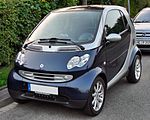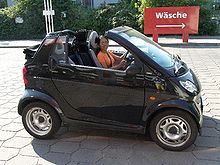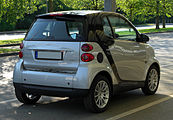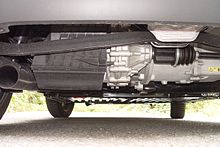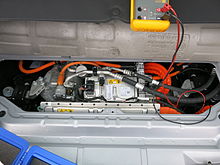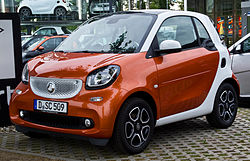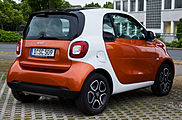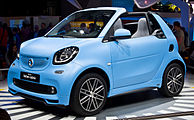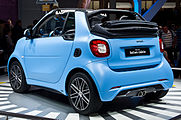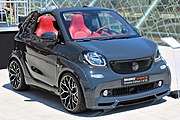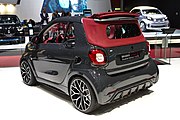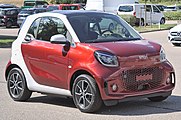Smart Fortwo
| Smart Fortwo | |
|---|---|
| Production period: | since 1998 |
| Class : | Microcar |
| Body versions : | Station wagon , convertible , roadster |
The Smart Fortwo (as a brand: smart fortwo ), which was known as the smart city coupé until the beginning of 2004 , is a small city car . It is the first model from the Smart car brand .
Until July 2013 1.5 million Fortwo ran the factory Smartville in the French Hambach off the line.
History of origin
The developments started before 1993 originally as Swatch -Car of Nicolas Hayek . A small car with an electric drive or a hybrid drive should be created. In cooperation with Volkswagen , however, VW was unable to decide to go into production, and disputes arose with Hayek. Hayek then turned to Mercedes. Two design studies were carried out by March 1994. Since MCC abandoned the original concept of concentrating on the essentials reduced to the max as well as the planned electric or hybrid drive, both Hayek and leading members of the development team left the project. "Today's gasoline-powered Smart is a product from Daimler-Benz and has nothing in common with the plans of the former Swatch team."
Hayek's idea of the “storage towers” was adopted, which are glass tower-like parking garages for smart automobiles “to buy and take away”. Hayek had the vision that everyone who had everything would have at least one smart car as a cult item, "for two people and two boxes of water" and that they would buy it in passing (analogous to Swatch watches).
In 1995 a design study of the vehicle now known as smart fortwo was presented at the IAA . The car was launched in Europe in October 1998 in the equipment variants pure and pulse . The vehicle shown on the first sales brochure had a black body (“Tridion safety cell”) with yellow panels made of colored plastic. In 1999, a third was added with the passion equipment variant .
The diesel version of the Smart Fortwo has CO 2 emissions of 88 grams per kilometer (g / km). With the introduction of the revised second generation Fortwo model in autumn 2010, CO 2 emissions in the NEDC were reduced to 86 g / km. After the Kia Rio 1.1 CRDi ISG (85 g / km in the same test cycle), it has the second lowest CO 2 emissions among the large-scale vehicles with combustion engines produced in 2010.
Smart 450 City Coupé / Fortwo (1998-2007)
| 1st generation | |
|---|---|
|
Smart City Coupé (1998–2002) |
|
| Production period: | 1998-2007 |
| Body versions : | Station wagon , convertible , roadster |
| Engines: |
Otto engines : 0.6–0.7 liters (33–55 kW) Diesel engines : 0.8 liters (30 kW) |
| Length: | 2500 mm |
| Width: | 1510 mm |
| Height: | 1520 mm |
| Wheelbase : | 1812 mm |
| Empty weight : | 720-805 kg |
| Stars in the Euro NCAP - Crash Test |
|
The Fortwo (internal: C 450 , Coupé - A 450 , Cabriolet) is a rear-wheel drive, two-seater car that is 2.5 m long, 1.51 m wide and 1.52 m high. It is powered by a three - cylinder turbo engine , initially with a displacement of 599 cm³ and an output of 33 kW (45 PS ), 40 kW (54 PS), and from the facelift 2003 45 kW (61 PS). The engine is limited as standard at 135 km / h. In the petrol engine version , the Smart Fortwo consumes 5.5 to 6.5 liters of super petrol per 100 km, depending on the tires and driving style. The engine's output can be increased to around 59 kW (80 PS) through chip tuning ; the electronic limitation is usually also canceled, thereby significantly increasing the top speed. The engine is installed behind the seats under the trunk in front of the rear axle. As standard he has an ESP (until the beginning of 2003 than in the form of a trust Plus designated and without braking intervention only by throttling and disengaging the engine responsive "emaciated" system, later as a full ESP), ABS , Airbags and a sequential automated six gang - Manual , depending on the equipment with optional automated switching. The complete rear axle unit, including the engine and transmission, is manufactured for Smart in one of the four branches of the cross-shaped Smart factory from Thyssenkrupp Automotive. The ESP was not planned during the construction of the Smart, only the repeated overturning of the Smart in the so-called moose test - the missing, but originally planned battery in the floor pan was noticeable - led to the decision to delay delivery by six months and, for the time being, that Retrofit Trust-Plus. The load-bearing basis of the vehicle is the so-called Tridion safety cell made of high-strength steel , to which the other body parts made of thermoplastic and the assemblies were then attached. The front chassis consists of MacPherson struts with triangular links (1998–1999 GRP leaf springs) with rack and pinion steering (very rarely with electric power steering). At the rear there was a rigid De-Dion axle with coil springs and hydraulic shock absorbers, whose U-shaped bent axle tube is mounted on the chassis as a drawbar axle in front of the engine and is guided at the rear by two wishbones (like a Panhard rod ). Soft rubber bearings compensate for the changing distance between the suspension points. Forwards are disc , rear drum brakes installed.
In November 1999, a revised model was released on the chassis (coil springs in spring struts instead of GRP leaf springs) and in the interior (standard fabric color gray instead of blue). From January 2000 the Smart Fortwo was also available with a common rail diesel , internal designation OM 660 . With a displacement of 0.8 liters (799 cm³) and three cylinders, this engine was the smallest mass-produced passenger car diesel engine in the world at the time, with a standard consumption of 3.3 l / 100 km and an output of 30 kW (41 hp).
Perpendicular parking
Because it is only 2.5 meters long, two Smart Fortwo often fit in a normal parking space. There are also special small smart parking spaces (so-called “3-meter parking spaces”) in various parking garages.
It is controversial whether the perpendicular parking practiced by some smart drivers violates the German Road Traffic Act (StVO). According to § 12 Abs. 4 StVO there is no clear requirement to park parallel to the edge of the road. However, perpendicular parking violates the StVO if the perpendicular parking vehicle protrudes from the parking space so far that the flowing traffic is obstructed and endangered. On the other hand, perpendicular parking is permitted if the local conditions permit, i.e. either the parking space is wide enough or "dead" space that cannot be used by normal vehicles can be used for parking next to the parking lot.
In Austria, parking across the street is a violation of Section 23 (2) of the StVO .
The Vienna Convention on Road Traffic also states in Art. 23 para. 2 lit. b Parallel parking in front of you, except where local conditions allow otherwise.
plagiarism
The Shuanghuan Noble looks similar to the Smart Fortwo, but differs technically.
gallery
Facelift (2003)
In January 2003, the revised 2nd generation version of the Smart Fortwo appeared with a larger gasoline engine with a displacement of 698 cm³, an output of 37 kW (50 PS) or 45 kW (61 PS) and extended ESP with braking intervention on individual wheels. Once again, the chassis was revised and the body was raised by 10 mm because the ESP now compensated for the dynamic influences of the higher center of gravity.
The drag coefficient of the car is 0.37.
Fortwo 450 Brabus
The Smart-Brabus joint venture started producing Smart Fortwo models in 1999, which were optically and technically refined.
The first generation Smart-Brabus Fortwo was a direct descendant of the Brabus 1st Edition , the first special model. The vehicles were equipped with an upgraded 0.7-liter engine with 55 kW (75 hp), sports suspension and an electronic speed limiter that allowed a top speed of 150 km / h. Outwardly, they differed from the production model by special wheels, wider tires, more shaped sills painted in the same color as the car, widened rear fenders, a modified front mask , a twin-pipe sports exhaust located in the middle of the rear, and an upgraded interior.
Fortwo 450 Brabus 101
In addition, in 2005, Brabus offered a special model “Brabus-smart fortwo 101” limited to 101 vehicles. This special model cost 39,900 euros and offers, in addition to a special paint finish in Racing Red (Ferrari Red), which also includes the safety cell, an engine that has been upgraded to 74 kW (99 PS). The acceleration from 0 to 100 km / h was 11.9 s; the top speed was limited to 160 km / h. The chassis and tires were adapted to this speed. 35 vehicles had been sold by the 2005 IAA.
Fortwo 450 convertible
The Smart Fortwo Cabrio is a convertible with an electrically opened fabric roof and removable roof bars. It was introduced in March 2000. The engine and equipment of the Smart Fortwo Cabrio correspond to a Fortwo Coupé (petrol engine with 45 or 50 hp not available). The electric soft top can be used openly in three different versions. On the one hand, the convertible top can be opened and closed electrically up to the roll bar while driving. The rear part of the convertible top can be unlocked electrically at the push of a button, but you have to push it into the lock by hand so that it lies folded over the trunk lid. In this open position, the side roof pillars can be removed and stowed in the holders provided in the tailgate. That reinforces the feeling of sitting in a convertible. After it has been unlocked electrically, the roof can be closed by hand. When closed, the rear part of the convertible top can be folded up halfway over the trunk flap for better loading. The fabric top comes from Webasto .
From the 2001 model year ( 1st generation ), the convertible in the pulse and passion model variants was given a headliner covered with light fabric. The smart convertible with CDI diesel engine is the world's only 3-liter convertible in series production. In spring 2005 the special edition sunray appeared for the convertible with a soft top in red and standard paint in the special color flare black metallic. In addition, a radio with CD changer and a sound package were integrated as standard. The sunray edition was limited to a total of 1500 copies for the convertible and coupé.
Crossblade
The Smart Crossblade was a roadster that was developed by Bertrandt AG as general contractor and converted in small series by Binz from the smart fortwo cabrio & pure . It had no roof and no windshield. Instead of conventional doors, there were only narrow safety bars on the sides. The Smart Crossblade was a fun car designed for pure fair weather driving. The roadster, which was produced between March 2002 and December 2003, was available from June 2002 at a price of € 24,360; Only 1,995 units were built, although a limit of 2,000 units was communicated. The vehicle was weatherproof and could even be driven through a standard car wash, as there were several water drains in the vehicle and all relevant parts of the interior were redeveloped accordingly.
The Crossblade with the serial number "0001" was demonstrated by Robbie Williams on his 2002 tour and then auctioned on eBay . In 2002, 51,049.99 euros were achieved, which went to the Robbie Williams Foundation "Give It Sum".
Fortwo 450 Electric Drive
As early as 2006, 100 Smarts with electric drives were tested in a large-scale trial in London. This version (later called ED 1) was based on the 450 series of the ForTwo. The electric version had a 30 kW motor, with which the vehicle reached approx. 100 km / h. The range stated was up to 115 kilometers. The traction battery used was a Zebra battery (sodium-nickel chloride cell) that had already been tried and tested in other automobiles , with a capacity of 13.5 kWh.
Smart K
The Smart K is a special model especially for Japan , where there are simplified registration regulations (e.g. no parking permit required in metropolitan areas, low taxes) for small vehicles with a displacement of up to 660 cubic centimeters ( kei cars ).
The Smart K differs from the Fortwo Coupé by its smaller width of 1,470 m (1,510 m normal fortwo coupé ), a weight of 750 kg (770 kg normal Fortwo ) and a displacement of just 598 cm³. It is not available as a convertible. Otherwise, the interior and accessories do not differ from the normal Fortwo Coupé.
Production of the Smart K was discontinued in 2004.
Technical specifications
| model | cylinder | Displacement | power | Torque | construction time |
|---|---|---|---|---|---|
| Petrol engines | |||||
| smart city-coupé | 3 | 599 cc | 33 kW (45 hp) at 5250 min -1 | 70 Nm at 3000 min -1 | 1998-2003 |
| smart city-coupé | 3 | 599 cc | 40 kW (55 hp) at 5250 min -1 | 80 Nm at 3000 min -1 | 1998-2001 |
| smart city-coupé | 3 | 599 cc | 45 kW (61 hp) at 5250 min -1 | 88 Nm at 2250 min -1 | 2001-2003 |
| Smart | 3 | 698 cc | 37 kW (50 hp) at 5250 min -1 | 80 Nm at 1800 min -1 | 2003-2006 |
| Smart | 3 | 698 cc | 45 kW (61 hp) at 5250 min -1 | 95 Nm at 2000 min -1 | 2003-2006 |
| Smart Brabus | 3 | 698 cc | 55 kW (75 hp) at 5250 min -1 | 110 Nm at 3000 min -1 | 2003-2006 |
| Diesel engines | |||||
| smart city-coupé cdi | 3 | 799 cc | 30 kW (41 hp) at 4200 min -1 | 100 Nm at 1800 min -1 | 1999-2002 |
| Smart cdi | 3 | 799 cc | 30 kW (41 hp) at 4200 min -1 | 100 Nm at 1800 min -1 | 2004-2006 |
Smart 451 Fortwo (2007-2015)
| 2nd generation | |
|---|---|
|
Smart Fortwo Coupé mhd Passion (2007-2010) |
|
| Production period: | 2007-2015 |
| Body versions : | Kombicoupé , convertible |
| Engines: |
Gasoline engines : 1.0 liter (45–75 kW) Diesel engines : 0.8 liters (33–40 kW) Electric motors : 55–60 kW |
| Length: | 2695 mm |
| Width: | 1559 mm |
| Height: | 1542 mm |
| Wheelbase : | 1867 mm |
| Empty weight : | 825-945 kg |
| Stars in the Euro NCAP - Crash Test |
|
The successor to the Smart Fortwo (internal: C 451 , Coupé - A 451 , Cabriolet) has been available since March 2007 . With this model, Smart is also about opening up new markets (e.g. in the United States ) and meeting all applicable legal requirements (such as pedestrian protection ). The vehicle is 19.5 centimeters longer, but retains its character. “Cross parking” is generally no longer possible due to the length. On November 9th, 2006 the new Fortwo was presented in Stuttgart. Almost all of the technology - 90% of the parts are new - has been revised, including a new range of engines and a new five-speed gearbox, which is supposed to work significantly softer than the previous six-speed gearbox. The price is roughly the same as the old model. The convertible and electric drive versions of the old model will continue to be sold.
The “Crosstown” study with the technology of the new Fortwo was shown at the IAA 2005.
Some properties have been changed in the second generation. The engines became more economical (e.g. cdi: 3.3 l / 100 km instead of 3.8 l / 100 km, corresponding to CO 2 emissions of 88 g / km). The longer wheelbase improves driving comfort; However, due to the increased length, perpendicular parking is hardly possible without significantly impairing traffic. The new transmission causes less “nodding” and has five gears and two shift drums. The top speed is now limited to 145 km / h (155 km / h for the Brabus model and 135 km / h for the diesel) (135 km / h for the previous model).
The 451 series convertible has a heated glass rear window instead of the previous plastic window, and the convertible top can now be lowered and raised completely electrically without an intermediate step. However, the longitudinal spars still have to be removed by hand.
According to the ADAC , the smart fortwo coupé 1.0 mhd pure softip, together with the Toyota Aygo, is the most cost-effective car in the subcompact class (as of March 2010).
Since 2008 and 2007, the Smart has been equipped with a start-stop system in the 45 and 52 kW output levels of the gasoline engines. Although Smart uses the term “Micro Hybrid Drive” (“mhd” for short) for this, the technology has nothing in common with a hybrid electric vehicle due to the lack of a second drive . If the driver brakes to a standstill, for example at a traffic light, the system automatically switches the motor off from a speed of less than eight km / h and starts it again when the brake is released. This is intended to reduce consumption in city traffic. The system did not exist for the diesel engine, although it was announced in 2007.
The drag coefficient is 0.34.
Facelift (2010)
In summer 2010 the facelift of the Fortwo, which has been delivered since September, was presented. Apart from the optional, boomerang-shaped daytime running lights, the exterior of the model has not changed much. New colors were introduced and the scope of the paintwork expanded. The convertible version received new top fabrics. In the interior there is, among other things, a newly shaped instrument panel, new fabrics and patterns as well as an iPhone integration. The engines have also been revised. The diesel engine reaches 86 g / km; the petrol engines with a start-stop function with 45 kW / 61 PS or 52 kW / 71 PS come to 98 g / km and the version with 62 kW / 84 PS to 114 g / km. The version from Brabus with 75 kW / 102 PS has CO 2 emissions of 119 g / km.
Facelift (2012)
On May 12, 2012, another model that had undergone another facelift came onto the market across Europe. The radiator grille with the Smart logo has been enlarged and the front apron has been redesigned; the fuel cap is delivered in the same color as the vehicle. The optionally available LED daytime running lights are now arranged completely horizontally. Furthermore, the side skirts and the rear apron are new. There are no changes in the interior apart from new colors. The range of engines also remained untouched.
Fortwo 451 Brabus
The Smart-Brabus Fortwo of the second series had a 72 kW (98 PS) strong 1.0-liter turbo engine with a maximum torque of 140 Nm until autumn 2010. The acceleration from 0 to 100 km / h was 9.9 s. The improvement compared to its predecessor was mainly achieved through the new 5-speed gearbox, which has shorter shift pauses than the 6-speed gearbox of the first generation and which already reaches 100 km / h in third instead of fourth gear. With the facelift in autumn 2010, the Brabus got a 75 kW (102 hp) engine. With this 100 km / h are reached after 8.9 s. The maximum torque of the engine increased to 147 Nm.
Fortwo Electric Drive
Fortwo 451 ED 2 (2009)
The next version, ED 2, had a lithium-ion battery with a capacity of 16.5 kWh. This battery was manufactured by Tesla Motors . The top speed of the Smart ED 2 is 112 kilometers per hour, the energy requirement is around 12 kWh / 100 km. A total of 2,100 copies of these vehicles were produced in the Smart factory in Hambach, France, from the end of 2009. The Smart ED 2 (abbreviated from Electric Drive ) were initially used in the fleet test for electric mobility called E-Mobility Berlin in cooperation with RWE . Further copies were leased as fleet vehicles and later used by the car sharing provider car2go . You couldn't buy this model. From 1000 of the used batteries, a 13 MWh electricity storage system was bundled in Lünen , allegedly the world's largest 2nd-use battery storage system.
Conversions
Until mid-2012, interested parties could only buy Smarts that were individually converted to electric drive by several smaller manufacturers. The conversion kits developed for this enable the original combustion engine car to be converted to an electric drive in a few days.
Fortwo 451 ED 3 (2012-2015)
A revised model of the Fortwo Electric Drive, the Smart ED 3, was presented at the IAA 2011. This model had a 50 kW electric motor with a torque of 130 Nm. The lithium-ion battery from Deutsche Accumotive has a capacity of 17.6 kWh, which enables a range of over 140 kilometers. The acceleration to 60 km / h takes 4.8 seconds, 100 km / h is reached after 11.5 seconds. The top speed is 125 km / h.
From mid-2012 the Smart ED 3 was available on the market as a coupé and convertible. As standard, the engine can call up 55 kW of power. In the special Brabus model , the output has been increased to 60 kW. The Smart ED 3 can be charged in around seven hours from a conventional 230 V / 16 A socket with up to around 13 A (3300 W). With an optional charging cable with type 2 plug , the full power (charging time 6 hours) of the 3.7 kW on-board charger can be used at charging pillars / wall charging stations . Charging with up to 22 kW is possible using an optional charger, with which the charging currents can be flexibly adjusted. It reduces the charging time to less than an hour. Smart indicates the range of a single charge as 145 km. Consumption is given as 15.1 kWh (homepage) or 13.3 kWh (commercial) per 100 km. In the ADAC test, the Smart ED consumed 13.04 kWh / 100 km. This corresponds to the energy content of 1.47 liters of gasoline.
The battery did not have to be bought when buying a Smart ED 3, but was rented by 90% of customers ( sale & care € 65 per month). This kept the new price of the vehicle as well as the risk of possible problems low. The status (charge, range, next charging station, preconditioning) of the vehicle could be checked and controlled via a smartphone app . The app has since been discontinued.
In 2012, Daimler acquired its own wind power plant in order to provide the electricity required to operate 2500 smart fortwo electric drives sold in Germany in a CO 2 -neutral manner. The Enercon E-82 wind farm with a nominal output of 2.3 MW is located at Helmbrechts in Upper Franconia around 150 meters from the A9.
In Germany, the Smart ED 3 could also be found in road traffic research projects. In 2012–2015, participating companies from the region drove Smart ED 3 in the Bremen / Oldenburg region as part of the research project Company Initiative Electromobility (UI ELMo) in order to make the topic of electromobility better known.
In August 2015, MB Smart announced the cessation of production of the Smart ED 3, although at that time it was the second best- selling electric car in Germany after the BMW i3 and before the Renault ZOE .
As in Lünen, a battery storage power plant with a total storage capacity of 15 MWh was built in Hanover from 2016 together with the municipal utility ( Enercity ) and the subsidiary Deutsche ACCUmotive . This uses 3000 of the battery modules kept as replacements for the discontinued Smart ED3 model. The carmaker promised to keep spare parts available for 15 years from the purchase of the car and is meanwhile using them for additional business on the German market for primary control power (PRL). A further 9.8 MWh of storage capacity has been used in the Werdohl-Elverlingsen power plant since June 2018 .
The Smart Fortwo ED is integrated into the Car2go concept. This mobility concept allows short-term use of the vehicles on a minute-by-minute basis and, in contrast to traditional station-based car sharing programs, the rental and return location are flexible ( free floating ) in the business area. The majority of the vehicles used are currently equipped with a combustion engine. In Stuttgart only electric vehicles are on offer, 500 Smart Fortwo and 50 Mercedes B250e, a total of 550. The Stuttgart ED3 fleet will be replaced by current EQ models with 22 kW fast chargers from summer 2018.
Fortwo 451 Bo Concept
The Bo Concept special model, which was created in cooperation with the Danish furniture manufacturer Bo Concept and is based on the Passion equipment line, has been available to order since June 2013 . The limited special series was available from November 2013 as a coupe and a convertible at prices starting at 14,490 euros. The motors have an output of 52 to 55 kW.
Technical specifications
| Parameters | 1.0 | 1.0 mhd | 1.0 | 1.0 mhd | 1.0 | 1.0 Brabus | 0.8 cdi | ||
|---|---|---|---|---|---|---|---|---|---|
| Construction period | 03/2007–05/2008 | 05/2008–11/2014 | 03/2007–05/2008 | 08/2007–11/2014 | 03/2007–11/2014 | 03/2007–07/2010 | 07/2010–11/2014 | 03/2007–07/2009 | 07/2009–11/2014 |
| Engine characteristics | |||||||||
| Engine designation | M 132 E 10 | M 132 E 10 AL | OM 660 DE 8 LA | ||||||
| Engine type | R3 petrol engine | R3 diesel engine | |||||||
| Mixture preparation | Manifold injection | Common rail direct injection | |||||||
| Engine charging | - | turbocharger | |||||||
| Bore × stroke | 72.0 x 81.8 mm | 65.5 x 79.0 mm | |||||||
| Displacement | 999 cm³ | 799 cc | |||||||
| Max. power | 45 kW (61 PS) at 5800 rpm |
52 kW (71 PS) at 5800 rpm |
62 kW (84 PS) at 5250 rpm |
72 kW (98 PS) at 5500 rpm |
75 kW (102 PS) at 6000 rpm |
33 kW (45 PS) at 3800 rpm |
40 kW (54 PS) at 3800 rpm |
||
| Max. Torque | 89 Nm at 3000 rpm |
92 Nm at 4500 rpm |
120 Nm at 3250 rpm |
140 Nm at 3500 rpm |
147 Nm at 2500-3600 rpm |
110 Nm at 2000-2500 rpm |
130 Nm at 2100-2600 rpm |
||
| Power transmission | |||||||||
| Drive, as standard | Rear wheel drive | ||||||||
| Gearbox, as standard | automated 5-speed manual transmission | ||||||||
| Readings | |||||||||
| Top speed | 145 km / h | 155 km / h | 135 km / h | ||||||
| Acceleration, 0-100 km / h |
16.7 s | 16.8 s | 13.3 s | 13.7 s | 10.7 s | 9.9 s | 8.9 s | 19.8 s | 16.8 s |
| Fuel consumption over 100 km (combined) |
4.7 l super | 4.2-4.3 l super | 4.7-4.9 l super | 4.2–4.4 l super | 4.9 l super | 5.4 l Super Plus | 5.2 l super plus | 3.3 l diesel | 3.3 l diesel |
|
CO 2 emissions (combined) |
112 g / km | 97-98 g / km | 112-116 g / km | 97-100 g / km | 114-115 g / km | 124 g / km | 119 g / km | 88 g / km | 86-87 g / km |
|
Emission standard according to EU classification |
Euro 4 | 5 euro | Euro 4 | Euro 4; 5L | 5 euro | Euro 4 | 5 euro | ||
The abbreviation stands mhd at the Smart for M icro H YBRID D rive. However, this is only an automatic start-stop system. There is no electric motor alongside the combustion engine.
| electric drive | Brabus electric drive | ||||
|---|---|---|---|---|---|
| Construction period | 06 / 2012–08 / 2015 | 09 / 2012-08 / 2015 | |||
| Engine characteristics | |||||
| Engine designation | |||||
| Engine type | AC - synchronous motor | ||||
| Battery type | Lithium Ion Battery | ||||
| Battery capacity | 17.6 kWh | ||||
| Continuous output According to ECE R85 | 35 kW (48 hp) | 35 kW (48 hp) | |||
| Maximum power | 55 kW (75 PS) | 60 kW (82 PS) | |||
| Max. Torque | 130 Nm | 135 Nm | |||
| Power transmission | |||||
| Drive, as standard | Rear wheel drive | ||||
| Gearbox, as standard | 1-speed gearbox | ||||
| Readings | |||||
| Top speed | 125 km / h | 130 km / h | |||
| Acceleration 0–60 km / h / 0–100 km / h | 5.0 s / 11.5 s | 4.4 s / 10.2 s | |||
| Empty weight with driver 68 kg and luggage 7 kg | 975 kg (995 kg convertible) | 1000 kg (1020 kg convertible) | |||
| Power consumption (combined) according to Regulation (EC) No. 715/2007 , when charging at 230 V / 8 A. | 15.1 kWh / 100 km | 16.3 kWh / 100 km | |||
| Range according to NEDC, ECE R101 | 145 km | ||||
Smart 453 Fortwo (since 2014)
| 3rd generation | |
|---|---|
|
Smart Fortwo (2014-2019) |
|
| Production period: | since 2014 |
| Body versions : | Combi coupe |
| Engines: |
Otto engines : 0.9–1.0 liters (45–92 kW) Electric motor : 61 kW |
| Length: | 2695-2740 mm |
| Width: | 1663 mm |
| Height: | 1543-1555 mm |
| Wheelbase : | 1873 mm |
| Empty weight : | 880-1040 kg |
| Stars in the Euro NCAP - Crash Test (2014) |
|
The third generation of the Smart Fortwo was presented to the public on July 16, 2014. With its Tridion safety cell, it is based on the design of the previous models. It consists of 75% high-strength steel . After the sales release on July 31, 2014, the model was launched on November 22, 2014. It was developed in cooperation with Renault . The price of the new Smart Fortwo in the simplest version remains unchanged at 10,895 euros even in the third generation. While the length remained the same compared to the second generation, the width increased to 1.66 m and the height to 1.55 m. The wheelbase is given as 1.87 m. With a maximum steering angle of the front wheels of 51 degrees, the turning circle was reduced to 6.95 m and the turning circle to 7.30 m. The trunk holds 260 l up to the load cover and 350 l up to the roof. The maximum load is specified as 270 kg. Characteristic of the third generation is the larger radiator grille with a honeycomb pattern with an enlarged logo. Because of the pedestrian protection requirements, the third generation received a small front end. The diamond-shaped headlights offer LED daytime running lights as standard, in conjunction with the LED package with U-shaped fiber optics. The bead in the door was retained.
Two gasoline engines were offered for the market launch: on the one hand a 1.0-liter in-line three-cylinder with an output of 52 kW (71 hp), and on the other hand a turbocharged 0.9-liter in-line three-cylinder with an output of 66 kW (90 hp). At the beginning of 2015, a reduced output level from the 1.0 liter engine with 45 kW (61 hp) came onto the market. All engines meet the Euro 6 emissions standard and have an automatic start-stop system as standard (not on the 45 kW variant). A diesel engine is not offered.
For the first time, an ordinary manual transmission with five gears is standard for the fortwo . The new twinamic six-speed dual clutch transmission is available on request .
The chassis of the Smart Fortwo has MacPherson struts at the front and a DeDion axle at the rear, with the spring travel up to 30 millimeters longer and the track widened. A special feature in this vehicle class is the standard Crosswind Assist, which is activated from a speed of 80 km / h. A driver airbag, a front passenger airbag, sidebags for the driver and front passenger and a knee airbag for the driver are fitted as standard.
The drag coefficient deteriorated compared to the previous model to 0.38, the frontal area increased from 2.06 m² to 2.25 m².
In the summer of 2015, Smart announced that it would be launching a 453 series convertible from 2016. The price is higher than that of the coupé, the construction of the top is essentially the same as that of the 451 convertible. The c w value of the convertible is 0.36.
In the fall of 2018, Smart announced that the last gasoline engines would be sold in 2019. Customer orders for the 71-hp vacuum cleaner and the 90-hp turbo should be accepted until March 31, 2019.
Fortwo 453 Brabus
The Brabus versions of the forfour , fortwo and fortwo convertible were presented at the Beijing Motor Show in April 2016 . The 0.9 liter turbo engine has an output of 80 kW (109 hp) in all models. The Brabus versions went on sale in July 2016 at prices from 19,170 euros ( fortwo ). In contrast to the other Fortwo 453 models, Super Plus is required as fuel for the Brabus models. Construction of the 453 Brabus ended in spring 2018.
Fortwo 453 Brabus Ultimate 125
At the Geneva Motor Show in March 2017, the Brabus Ultimate 125, a 92 kW (125 PS) version of the fortwo limited to 125 units, was presented. The vehicle was available as a closed version from 49,980 euros and as a convertible from 52,800 euros.
Fortwo 453 Electric Drive (ED 4)
The fourth electric version (ED 4) in the third generation of bodywork was presented at the 2016 Paris Motor Show. This electric motor has been available in the fortwo , the fortwo convertible and, for the first time, in the forfour since 2017 . The Smart ED 4 can be recognized by the white lettering on the front and back, and by the ED plug logo. In the special Greenflash model , the Tridion cell and the exterior mirrors are painted in electric green . The tachometer from the models with a combustion engine was replaced by a power meter for the required power.
The electric motor is built by Renault in Cléon in northern France and has an output of 60 kW (81 hp). The maximum torque is 160 Newton meters, the maximum speed is regulated 130 km / h. The drive battery has a usable capacity of 16.7 kWh. It is being built by Deutsche ACCUmotive in Kamenz, Saxony , and consists of 96 cells from the supplier LG Chem . The range of the Elektro-Smart is up to 160 kilometers. The charging times can be reduced from six to 3.5 hours with a wallbox. For a surcharge, a 22 kW fast charger will come onto the market in 2018, which will fill the battery up to 80 percent in 45 minutes. In future, the charging of the battery can be controlled with a smartphone app. For example, the interior can be cooled or heated in order not to put additional strain on the battery later while driving.
When the model was launched in March 2017, the price for the cheapest Smart ED4 was 21,940 euros; to launch the Smart coupe and convertible was as special model Green Flash offered at prices starting at 27,839 euros.
In March 2018, the electric version was renamed Smart EQ , like the planned electric EQ family from Mercedes-Benz, with black-painted Nightsky special models. In addition, the 22 kW onboard charger will be available from May 2018 and will cost 840 euros extra. Older vehicles cannot be retrofitted. The “EQ Control” app was also announced.
Technical specifications
| Parameters | 1.0 | 1.0 | 0.9 | 0.9 Brabus | 0.9 Brabus Ultimate 125 |
|---|---|---|---|---|---|
| Construction period | 01 / 2015–07 / 2017 | 11/2014–06/2019 | 07/2016–08/2018 | 03/2017–08/2018 | |
| Engine characteristics | |||||
| Engine designation | M 281 E 10 | M281.920 | M281.910 | H4B 45X | H4B |
| Engine type | R3 petrol engine | ||||
| Mixture preparation | Manifold injection | ||||
| Engine charging | - | turbocharger | |||
| Displacement | 999 cm³ | 898 cc | |||
| Max. power | 45 kW (61 PS) at 6000 rpm |
52 kW (71 PS) at 6000 rpm |
66 kW (90 PS) at 5500 rpm |
80 kW (109 PS) at 5750 rpm |
92 kW (125 PS) at 5550 rpm |
| Max. Torque | 91 Nm at 2850 rpm |
91 Nm at 2850 rpm |
135 Nm at 2500 rpm |
170 Nm at 2000 rpm |
200 Nm at 2000 rpm |
| Power transmission | |||||
| Drive, as standard | Rear wheel drive | ||||
| Gearbox, as standard | 5-speed manual transmission | 5-speed manual transmission [6-speed dual clutch transmission] |
6-speed dual clutch transmission | ||
| Readings | |||||
| Top speed | 151 km / h | 151 km / h [151 km / h] |
155 km / h [155 km / h] |
165 km / h | 175 km / h |
| Acceleration, 0-100 km / h |
15.6 s | 14.4 s [15.1 s] |
10.4 s [11.3 s] |
9.5 s | 9.2 s |
| Empty weight (DIN) | 890 kg [935 kg] convertible 975 kg |
915 kg [940 kg] convertible 995 kg |
995 kg | ||
| Fuel consumption over 100 km (combined) |
4.5 l super | 5.0 l super [? l super] |
4.2 l super [4.1 l super] |
4.5 l super plus | 4.6 l super plus |
|
CO 2 emissions (combined) |
104 g / km | 115 g / km [? g / km] |
97 g / km [96 g / km] |
102 g / km | 104 g / km |
|
Emission standard according to EU classification |
Euro 6 | ||||
| Electric Drive | |
|---|---|
| Construction period | since 03/2017 |
| Engine characteristics | |
| Engine designation | |
| Engine type | AC - synchronous motor |
| Battery type | Lithium Ion Battery |
| Battery capacity, usable | 16.7 kWh |
| Max. power | 60 kW (81 hp) |
| Max. Torque | 160 Nm |
| Power transmission | |
| Drive, as standard | Rear wheel drive |
| Gearbox, as standard | 1-speed gearbox |
| Readings | |
| Top speed | 130 km / h (regulated) |
| Acceleration, 0-100 km / h |
11.5 s (convertible: 11.8 s) |
| Empty weight (DIN) | 1,010 kg |
| Electricity consumption (combined) in kWh / 100 km | 12.9 (convertible: 13.0) |
| Range (NEDC) | 160 km |
Smart forease
To mark the 20th anniversary of the brand, the Smart Forease concept vehicle was presented at the Paris Motor Show in October 2018 . It has a shortened windscreen and dispenses with a roof. This is intended to remind the vehicle of the Crossblade built between 2002 and 2003 . The concept vehicle is driven by an electric motor. At the Geneva Motor Show in March 2019, Smart presented the Forease + concept vehicle with a roof.
Smart Forease at the 2018 Paris Motor Show
Smart Forease + at the Geneva Motor Show 2019
Web links
Individual evidence
- ↑ Press release 10 years of the smart fortwo - a cult car celebrates its birthday
- ↑ 1.5 million smart fortwo from the Hambach production plant . ( Memento of the original from October 4, 2013 in the Internet Archive ) Info: The archive link was inserted automatically and has not yet been checked. Please check the original and archive link according to the instructions and then remove this notice. Engine vision
- ↑ Triumph of a tinkerer . In: Der Spiegel . No. 13 , 1994 ( online - for Hotzenblitz with mention of two design studies by Hayek).
- ↑ a b The car for a clear conscience . In: Die Zeit , No. 10/2007
- ↑ a b So Smart . brand eins online, 10/2001; accessed January 22, 2013
- ↑ Passion equipment variant , Smart Wiki
- ↑ Kia Rio: With three-cylinder turbodiesel to the CO2-saving master ( Memento of the original from January 24th 2012 in the Internet Archive ) Info: The archive link was inserted automatically and not yet checked. Please check the original and archive link according to the instructions and then remove this notice. , ATZ online
- ↑ Smart Fortwo City Coupe in the Euro NCAP crash test , euroncap
- ↑ Congratulations, Smart! , AutoBild, September 4, 2008, accessed June 30, 2012
- ^ BGH , ruling of May 9, 1962, Az. 4 StR 93/62, full text = BGHSt 17, 240.
- ↑ District Court Viechtach: Az. 7 II OWi 605-05 ( Memento of the original from January 31, 2012 in the Internet Archive ) Info: The archive link was inserted automatically and has not yet been checked. Please check the original and archive link according to the instructions and then remove this notice. (PDF; 381 kB)
- ↑ https://www.smartpit.de/10-jahre-smart-crossblade-ein-erfahrungsbericht/
- ↑ a b Jana Hoeffner: Star with a plug - electromobility at Daimler. Electrify-BW e. V., January 2015, accessed January 10, 2016 .
- ↑ Simon Bickerstaffe: Driving test. (No longer available online.) In: Automotive Engineer. December 1, 2010, archived from the original on January 10, 2016 ; accessed on January 10, 2016 . Info: The archive link was inserted automatically and has not yet been checked. Please check the original and archive link according to the instructions and then remove this notice.
- ↑ Smart Fortwo 2007 in the Euro NCAP crash test , euroncap
- ↑ Tom Grünweg: Just switch off . Spiegel Online , July 10, 2007
- ↑ New look, less consumption: Facelift for the Smart . In: n-tv. July 7, 2010, accessed July 7, 2010 .
- ↑ Markus Jordan: smart fortwo Facelift 2012: All details and prices . In: blog.mercedes-benz-passion.com. February 1, 2012, accessed February 1, 2012 .
- ↑ Strong, clean, economical ( memento of the original dated November 8, 2011 in the Internet Archive ) Info: The archive link was inserted automatically and has not yet been checked. Please check the original and archive link according to the instructions and then remove this notice. , smart.de
- ↑ How the Elektro-Smart drives , AutoBild, December 15, 2009, accessed on February 12, 2012
- ↑ Auto Motor und Sport, Issue 6 of February 25, 2010
- ↑ media.daimler.com The world's largest 2nd-use battery storage system goes online
- ↑ City 25/30/75 . Technical documentation of a Smart conversion to an electric drive, website company Turn-E, accessed on February 1, 2012
- ↑ Facts & Figures on the BEA-tricks conversion kit ( Memento of the original from January 23, 2012 in the Internet Archive ) Info: The archive link was automatically inserted and not yet checked. Please check the original and archive link according to the instructions and then remove this notice. , Information on the conversion kit and efficiency comparison, BEA-tricks website, accessed on January 20, 2012
- ↑ Smart fortwo electric drive: batteries from ACCUmotive, e-motor from EM-motive , elektroniknet.de, August 16, 2011
- ↑ smart fortwo ed: Drive ( Memento of the original from June 16, 2012 in the Internet Archive ) Info: The archive link was inserted automatically and has not yet been checked. Please check the original and archive link according to the instructions and then remove this notice. , smart.de. See also Smart ed / E-Bike: Schneller Elektroflitzer stern.de, August 16, 2011
- ↑ Simply electric - smart fortwo electric drive , dealer brochure, smart / Daimler AG
- ↑ Electromobility E-cars pass tough practical tests. ADAC: Ranges of up to 150 kilometers are no problem , press portal, October 1, 2012, accessed on October 14, 2012
- ^ Website of the manufacturer
- ↑ media.daimler.com: Moved by the wind - the new smart fortwo electric drive is completely emission-free
- ↑ Electromobility company initiative - UI ElMo (running time 2012–2015) , Electromobility model region Bremen / Oldenburg, accessed on September 6, 2013
- ↑ enercity.de Daimler and enercity are turning spare parts stores into energy stores
- ↑ http://media.daimler.com/marsMediaSite/de/instance/ko.xhtml?oid=40586809
- ↑ Smart Fortwo Edition Bo Concept: Limited special model available from 14,490 euros autosmotor.de
- ↑ The engine designation is encoded as follows: M = engine, OM = oil engine, series = 3 digits, E = manifold injection, KE = port injection, DE = direct injection, ML = compressor, L = charge air cooling, A = exhaust gas turbocharger, red. = reduced power / displacement.
- ↑ Result of the Smart Fortwo in the Euro NCAP crash test (2014)
- ↑ Smart Fortwo 453 at pkw.de (text below the first advertisements), accessed on July 22, 2018.
- ↑ The new Smart fortwo will be available in November 2014 ( memento of the original from August 10, 2014 in the Internet Archive ) Info: The archive link was inserted automatically and has not yet been checked. Please check the original and archive link according to the instructions and then remove this notice. , Car in the test of August 7, 2014, available on July 22, 2018.
- ↑ a b c Smart fortwo (C 453) at kenndeinauto.com , available on July 22, 2018.
- ↑ a b c Smooth and fun driving , auto-motor-und-sport.de from November 6, 2014 , accessed on July 22, 2018.
- ↑ a b Good in a nutshell , tagesspiegel.de of November 25, 2014 , available on July 22, 2018.
- ↑ The new smart fortwo cabrio. Driving pleasure in any weather. In: smartcenter.de. Retrieved August 31, 2015 .
- ↑ Smart ForTwo will also be available as a convertible again from spring. In: maz-online.de. Retrieved August 31, 2015 .
- ↑ The new smart fortwo cabrio - in the driving test through Valencia # BR453 at blog.mercedes-benz-passion.com , from January 27, 2016, accessed on July 22, 2018.
- ↑ 20.11.2018 smart petrol engine off; Mopf to the IAA
- ↑ Smart as strong as never before. April 25, 2016. Retrieved May 15, 2016 .
- ↑ 125 hp in an open two-seater. March 3, 2017, accessed March 3, 2017 .
- ↑ https://ev-database.de/pkw/1230/Smart-EQ-fortwo
- ↑ First ride in the new smart fortwo electric drive in Miami. November 18, 2016, accessed November 21, 2016 .
- ↑ Car2go renews its fleet. Retrieved January 11, 2018 .
- ↑ smart: open your mind. Accessed March 10, 2017 .
- ↑ Electric Drive is coming in 2017. September 23, 2016, accessed September 23, 2016 .
- ↑ Smart becomes fully electric. September 23, 2016. Retrieved September 23, 2016 .
- ↑ Electrical study with fresh air supply. October 2, 2018, accessed October 7, 2018 .
- ↑ Smart Forease +: Elektro-Smart carries a roof. March 1, 2019, accessed March 1, 2019 .




